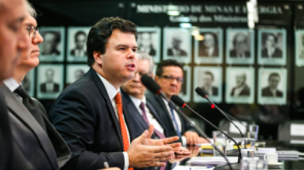Tempo de leitura: 3 minutos
Once again, Argentina is back to the drawing board. This time courtesy of Javier Milei, the newly elected libertarian president who has stunned the country and the international community with his rise to the Casa Rosada. The new president’s mantra, which roughly translates into “Long live freedom, dammit”, naturally resonates with the free zones community, which has made free trade and investment its raison d’être.
Lisandro Ganuza, who leads the regional office in South America of the World Free Zones Organization and heads international relations at PTP Group, discusses the prospects for the country’s free zones as Argentina seems to be on the cusp of opening up to foreign trade and investment.
Q: What is your proposal to develop further free zones in Argentina?
A: Investors are showing renewed interest in Argentina. What will the role of free zones be in this context? Even though the free zones regime has not changed in years, they can offer legal and technical stability. We are putting forward a proposal about the fiscal regime of free zones to add to a fiscal reform being discussed at the moment.
We are proposing to decrease the corporate income tax rate within free zones from the current 35% that applies across the country to 15%. It would comply with the global minimum tax, and we would gain in competitiveness and attract investment, instead of losing it.
One detail here stands out: of the 11 unicorns that were founded in Argentina, only one has kept its headquarters in the country. Many of them, like MercadoLibre or Globant, went to Uruguay, which has no corporate income tax in its free zones. I’ve spoken to a few officers in the national government and they provided positive feedback.
I think this is the right time to propose alternatives and stir up the interest of investors. I’ve repeatedly received interest from international funds for investment in the country. We need to make the most of it.
Q: What is the current free zones landscape in the country?
A: We have a dated free zones law tracing back to 1994, inspired by exports promotion. But it hasn’t offered any major incentives. Its main perk regards the capacity to import and stock goods free of duties, and stagger the release of the imported goods into the domestic economy, and thus also stagger the payment of tariffs.
That served well in the context of an economy that hadn’t opened up to foreign trade, with different governments regularly introducing tariffs to foreign trade. The country is now at a turning point as the new government is willing to integrate Argentina into the global economy.
Q: What are the main opportunities for free zone development?
A: Argentina’s plan to integrate into the global economy is based on four pillars, and free zones can develop accordingly.
The first is the development of non-conventional hydrocarbons like shale gas. We already have the Zapala free zone in the Vaca Muerta shale gas field, which is about to come online.
The second pillar revolves around lithium and mining. The Perico free zone in the Jujuy province, which was authorised last year, caters to that sector.
Another pillar regards the development of the waterway running along the Paraná basin, where we already have a free zone in Villa Constitución, which is already taking steps to become a hub for the production of fertilisers.
The fourth pillar is the knowledge economy. Overall we have 14 active free zones in the country.
Fonte/Foto: FDI Intelligence







Os comentários foram encerrados, mas trackbacks e pingbacks estão abertos.